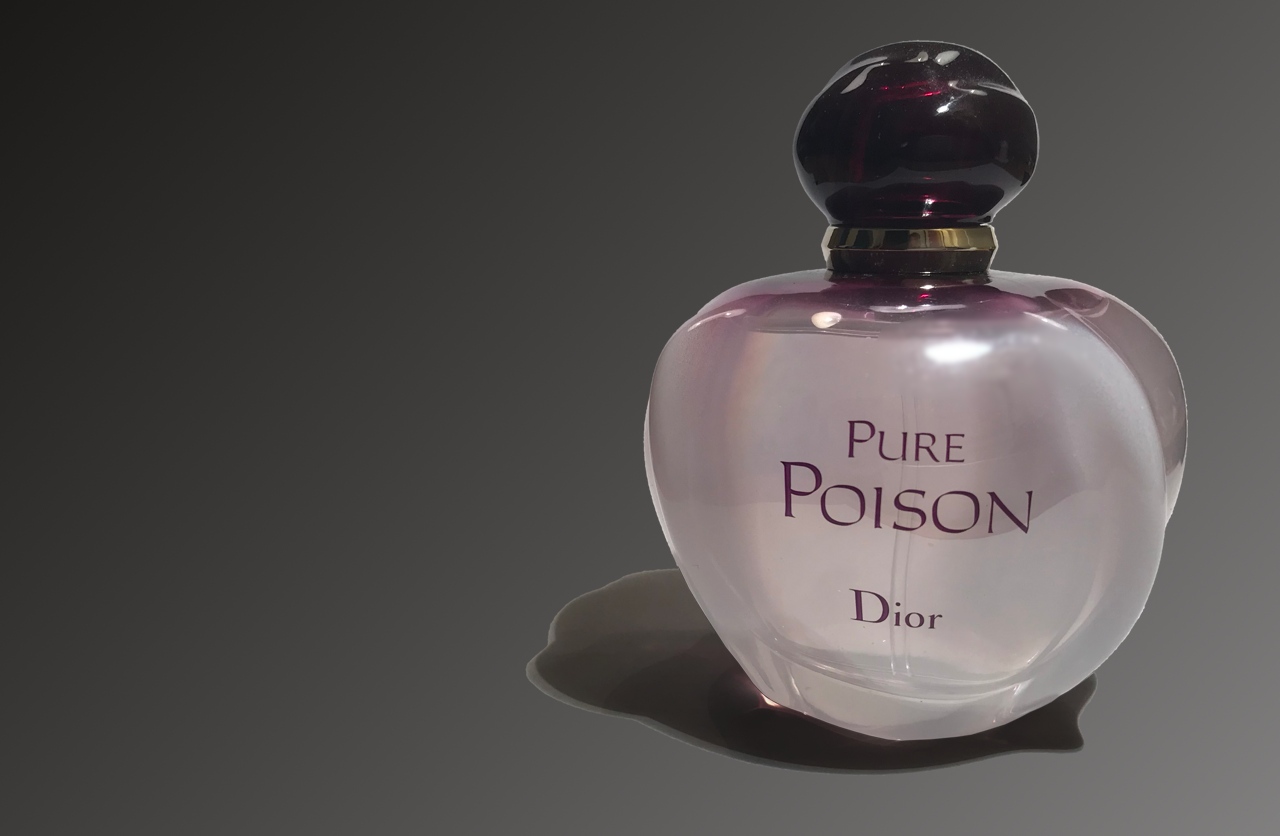Fragrance allergy: Balsam of Peru
11/26/2021 Food Intolerances
Most people have probably never heard of the term balsam of Peru, nevertheless, it is very likely that you come into contact with it on a daily basis. Balsam of Peru is a resin that is harvested from the balsam tree that occurs in Central America. The resin contains a broad spectrum of fragrances and essential oils, which makes it a very valuable ingredient for the cosmetics industry. Virtually all products that contain fragrances may contain one or more compounds from balsam of Peru.

▲ Of course this perfume is not pure poison, but an increasing number of people reacts allergic to certain compounds in perfumes.
* Propolis (bee glue) and balsam of Peru share a high number of common ingredients
Balsam of Peru contains a mixture of more than 200 different aromatic compounds. It has a fragrance that resembles vanilla. Its main ingredients are:
Basically all of these compounds occur naturally and are not per se harmful substances. However, some of them have a high sensitizing potential. It has been known for centuries that spices and essential oils may cause inflammatory skin reactions. In the 19th century, many workers who came into contact with vanilla on a daily basis suffered from contact dermatitis.
Because of its widespread use in cosmetics we come into contact with balsam of Peru on a daily basis – and also when the skin is damaged and impaired in its protective function. Applying agents with a high sensitizing potential may eventually lead to a sensitivity. Each of the substances listed above may cause dermatitis, with those body parts affected the most that come into contact with them the most: the hands and the face.
Women are affected by allergy to balsam of Peru far more often than men – 80 % of all allergy sufferers are female. The main reason for this is the routine use of cosmetics and perfumes. Interestingly, the number of allergies increases with age: Most affected persons are 40 years or older. The more you get exposed to the sensitizing agents, the higher the chance to develop an allergy. More than 10 % of the patients with skin eczema are allergic to balsam of Peru. Soon fragrance allergies, which have seen a massive rise in the last two decades, will most likely surpass nickel as the main eliciting factor for contact dermatitis. Therefore they should always be considered if there is an allergic skin disease.
Besides dermatitis, there are also less obvious symptoms: Oral reactions to the lips and tongue, throat tightness, gastrointestinal complaints, urticaria or a general feeling of discomfort up to panic attacks. Most of these symptoms will probably never be connected to an allergy to fragrances and it is very likely that it will be overlooked in many cases.
If you suspect an allergy to fragrances you should see an allergist. They will be able to identify an allergy with certain skin prick or patch tests. As each perfume alone can contain more than 300 different aromatic ingredients, it may be virtually impossible to identify each conflicting agent. Therefore, tests usually consist of flavor mixtures that contain the most frequent offending substances. The test result may not reveal each problematic agent, but it may be very helpful to narrow down the number of suspects.
The most effective therapy is the complete avoidance of all sensitizing fragrances. In order to do so, you will need to identify all products that contain them and if possible replace them with suitable alternatives. Some patients may also profit from changes in their diet.
As a consequence of their wide-spread use, fragrances are one of the main triggers of allergic contact dermatitis. For affected persons it is of great importance to avoid any contact with the allergens.
The label “fragrance free” does not necessarily protect you from all triggers. There are many natural plant extracts that are rich in aromatic compounds and essential oils which are in fact nothing else than fragrances. Therefore, natural cosmetics may also cause skin reactions. It is strongly advised to read the label carefully and scan for potential ingredients which are naturally high in aromatic compounds.
Back to blog

▲ Of course this perfume is not pure poison, but an increasing number of people reacts allergic to certain compounds in perfumes.
Which products contain balsam of Peru?
- Perfume
- Skin care products
- Soaps
- Hair care products
- Cosmetics
- Cosmetics with propolis*
- Toothpaste
- Mouthwashes
- Cigarettes and tobacco
- Household cleaners
- Dishwashing liquid
- Laundry detergent
- Fabric softener
- Scented candles
- Room freshener
- Medicines in cream form
- Medicines in juice form
- Lozenges
- Vitamin supplements
- Oil paints
- Coolants and lubricants
* Propolis (bee glue) and balsam of Peru share a high number of common ingredients
Which ingredients occur in balsam of Peru?
Balsam of Peru contains a mixture of more than 200 different aromatic compounds. It has a fragrance that resembles vanilla. Its main ingredients are:
- Benzoic acid and its derivatives
- Cinnamic acid and cinnamates
- Eugenol
- Vanillin
- Ferulic acid
- Coniferin
Why are these compounds so dangerous?
Basically all of these compounds occur naturally and are not per se harmful substances. However, some of them have a high sensitizing potential. It has been known for centuries that spices and essential oils may cause inflammatory skin reactions. In the 19th century, many workers who came into contact with vanilla on a daily basis suffered from contact dermatitis.
Because of its widespread use in cosmetics we come into contact with balsam of Peru on a daily basis – and also when the skin is damaged and impaired in its protective function. Applying agents with a high sensitizing potential may eventually lead to a sensitivity. Each of the substances listed above may cause dermatitis, with those body parts affected the most that come into contact with them the most: the hands and the face.
Who is affected?
Women are affected by allergy to balsam of Peru far more often than men – 80 % of all allergy sufferers are female. The main reason for this is the routine use of cosmetics and perfumes. Interestingly, the number of allergies increases with age: Most affected persons are 40 years or older. The more you get exposed to the sensitizing agents, the higher the chance to develop an allergy. More than 10 % of the patients with skin eczema are allergic to balsam of Peru. Soon fragrance allergies, which have seen a massive rise in the last two decades, will most likely surpass nickel as the main eliciting factor for contact dermatitis. Therefore they should always be considered if there is an allergic skin disease.
Besides dermatitis, there are also less obvious symptoms: Oral reactions to the lips and tongue, throat tightness, gastrointestinal complaints, urticaria or a general feeling of discomfort up to panic attacks. Most of these symptoms will probably never be connected to an allergy to fragrances and it is very likely that it will be overlooked in many cases.
Diagnosis and therapy
If you suspect an allergy to fragrances you should see an allergist. They will be able to identify an allergy with certain skin prick or patch tests. As each perfume alone can contain more than 300 different aromatic ingredients, it may be virtually impossible to identify each conflicting agent. Therefore, tests usually consist of flavor mixtures that contain the most frequent offending substances. The test result may not reveal each problematic agent, but it may be very helpful to narrow down the number of suspects.
The most effective therapy is the complete avoidance of all sensitizing fragrances. In order to do so, you will need to identify all products that contain them and if possible replace them with suitable alternatives. Some patients may also profit from changes in their diet.
Conclusion
As a consequence of their wide-spread use, fragrances are one of the main triggers of allergic contact dermatitis. For affected persons it is of great importance to avoid any contact with the allergens.
The label “fragrance free” does not necessarily protect you from all triggers. There are many natural plant extracts that are rich in aromatic compounds and essential oils which are in fact nothing else than fragrances. Therefore, natural cosmetics may also cause skin reactions. It is strongly advised to read the label carefully and scan for potential ingredients which are naturally high in aromatic compounds.
What role does diet play for balsam of Peru allergy sufferers?
 You can learn more about this and other topics in the in-app extension of our app Food Intolerances. Please not that this extension is not yet available for Android.
You can learn more about this and other topics in the in-app extension of our app Food Intolerances. Please not that this extension is not yet available for Android.
Share article
Share article
Back to blog
![[Blog]](../../rw_common/images/baliza_logo_retina.png)
